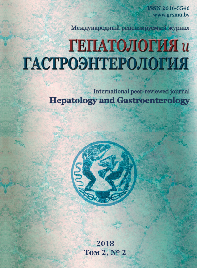COMPARATIVE EVALUATION OF THE ULTRAMICROSCOPIC FEATURES OF THE LIVER AFTER CLOSURE OF THE WOUND SURFACE WITH OMENTUM AND FLUOROPLAST-4 WITH MODIFIED SURFACE
Abstract
Background. Peritonization of wounds of parenchymal organs is essential in the prevention of postoperative complications. Traditional usage of omentum for this purpose has a number of significant drawbacks.
Objective. By methods of electron microscopy to evaluate the ultramicroscopic features of the liver in the area of closing its wound surface with an omentum and fluoroplast-4 with a modified surface (MF-4). Materials and methods. The experiment was carried out on white rats weighing 200-220 g, in whom marginal liver resection was performed. In the 1st group, the wound surface was closed with a strand of omentum on the vascular pedicle, in the 2nd group – by a flap of fluoroplast-4, the surface of which was modified by calcium chloride and a photosensitizer fotolon. Reaction of the liver was evaluated using electron microscopy with morphometry.
Results. It was found that when the wound of the liver was closed with an omentum and modified fluoroplast-4, similar changes developed at the submicroscopic level, which included both reparative and secretory reactions after surgery. This was manifested by the activation of the nuclear apparatus of hepatocytes and granular endoplasmic network, increased protein synthesis for their own cell needs as well as increased secretory activity of the Golgi complex. No significant structural changes in the mitochondria of hepatocytes and activation of collagen formation characteristic of fibrous and cirrhotic processes in the liver were revealed. Conclusion. The use of modified fluoroplast-4 does not cause destructive changes in the mitochondrial compartment of hepatocytes, which indicates the absence of local toxic effect.
References
1. Itala Je. Atlas abdominalnoj hirurgii [Atlas of Gastrointestinal Surgery]. Vol. 1, Hirurgija pecheni, zhelchnyh putej, podzheludochnoj zhelezy i portal’noj sistemy. Moscow: Medicinskaja literatura; 2006. 508 p. (Russian).
2. Alikhanov RB, Vishnevskiy VA, Kubyshkin VA, Ikramov RZ, Eshcanov RG, Kozyrin IA. Faktory riska razvitija posleoperacionnoj pechenochnoj edostatochnosti posle obshirnyh rezekcij pecheni [Risk factors predisposing and producing hepatic failure after major hepatic resection]. Kubanskij nauchnyj medicinskij vestnik [Kuban scientific Medical Bulletin]. 2013;7:51-53. (Russian).
3. Vishnevskij VA, Kubyshkin VA, Chzhao AV, Ikramov RZ. Operacii na pecheni [Operations on the liver]. Moscow: Miklosh; 2003. 158 p. (Russian).
4. Sigua BV. Novye tehnologii i takticheskie podhody v lechenii postradavshih s povrezhdeniem pecheni [New technologies and tactical approaches in the treatment of patients with liver damage] [Internet]. Medicina i obrazovanie v References Sibiri [Medicine and education in Siberia]. 2014;6:51-60. Available from: https://cyberleninka.ru/article/v/novyetehnologii-i-takticheskie-podhody-v-lechenii-postradavshihs-povrezhdeniem-pecheni. (Russian).
5. Li C, Zhang Y, Zhou J, Zhao G, Tang S. Therapeutic effect and tolerability of gelatin sponge particle-mediated chemoembolization for colorectal liver metastases: a retrospective study. World Journal of Surgical Oncology. 2013;11(1):222-225. doi: 10.1186/1477-7819-11-222.
6. Noritomi T, Yamashita Y, Kodama T, Mikami K, Hashimoto T, Konno T, Shirakusa T. Application of dye-enhanced laser ablation for liver resection. European Surgical Research. 2005;37(3):153-158. doi: 10.1159/000085962.
7. Bondarevskij IJa, Bychkovskih VA. Rezekcija pecheni i pochki: tehnicheskoe obespechenie operacij i plasticheskie materialy [Liver and kidney resection: technical support of operations and plastic materials]. Vestnik Juzhno Uralskogo gosudarstvennogo universiteta [Bulletin of South Ural State University]. 2011;26(28):67-70. doi: 10.14529/ozfk11.26.16. (Russian).
8. Borisov AE, Kubachev KG, Muhiddinov NB. Problemy diagnostiki i lechenija izolirovannoj i sochetannoj travmy pecheni]. Jeksperimentalnaja i klinicheskaja gastrojenterologija [Experimental and clinical gastroenterology]. 2007;4:100-103. (Russian).
9. Condon RE, Nyhus LM. Complications of groin hernia and of hernial repair. Surgical Clinics of North America. 1971;51(6):1325-1336.
10. Belozerskaya GG, Makarov VA, Zhidkov EA, Malikhina LS, Sergeeva OA, Ter-Arutyunyants AA, Makarova LV. Gemostaticheskie sredstva mestnogo dejstvija: (obzor) [Local hemostatics: (review)]. Khimiko-Farmatsevticheskii Zhurnal [Pharmaceutical Chemistry Journal]. 2006;40(7):9-15. (Russian).
11. Chizhikov GM, Bezhin AI, Ivanov AV, Maystrenko AN, Lipatov VA, Netyaga AA, Zhukovsky VA. Jeksperimentalnoe izuchenie novyh sredstv mestnogo gemostaza v hirurgii pecheni i selezenki [Experimental study of new drugs of local hemostasis in surgery of liver and spleen]. Chelovek i ego zdorove [Man and His Health]. 2011;1:20-22. (Russian).
12. Kudla VV, Zhuk IG, Kravchuk RI, Kurbat МА, Zhmailik RR. Ultramikroskopicheskaja sravnitelnaja ocenka reakcii pecheni na zakrytie ee ranevoj poverhnosti salnikom i ftoroplastom [Ultramicroscopic Comparative Evaluation of the Tissue Reaction of the Liver to the Closure of its Wound Surface by the Omentum and Fluoroplastic] [Internet]. Novosti Khirurgii. 2016;24(4):328-335. doi: 10.18484/2305-0047.2016.4.328. Available from: https://elib.vsmu.by/bit-stream/123/10218/1/nkh_2016_4_328-335.pdf. (Russian).
13. Khvorostov ED, Cherkova NV. Dinamika izmenenij ultrastruktury kletok pecheni posle vozdejstvija jelektrokoagul-jacii i ultrazvuka v jeksperimente [The action of chandes of ultrastructure of hepar cells after influence of electrocoagulation and ultrasound in experiment] [Internet]. Vestnik Harkovskogo nacionalnogo universiteta imeni VN Karazina. Serija Medicina [The Journal of VN Karazin Kharkiv National University, series Medicine]. 2008;16(831):33-36. Available from: https://periodicals.karazin.ua/medicine/article/view/6980/6463 Russian).
14. Nepomnyashchikh GI, Aidagulova SV, Nepomnyashchikh DL, Kapustina VI, Postnikova OA. Ultrastrukturnoe i immunogistohimicheskoe issledovanie zvezdchatyh kletok pecheni v dinamike fibroza i cirroza pecheni infekcionno-virusnogo geneza [Ultrastructural and immunohistochemical study of hepatic stellate cells over the course of infectious viral fibrosis and cirrhosis of the liver]. Bjulleten jeksperimentalnoj biologii i mediciny [Bulletin of Experimental Biology and Medicine]. 2006;142(12):681-686. (Russian).
15. Chencov JuS. Vvedenie v kletochnuju biologiju. 4th ed. Moscow: Akademkniga; 2004. 493 p. (Russian).
16. Baidyuk EV, Shiryaeva AP, Bezborodkina NN, Sakuta GA. Sravnitelnyj analiz morfofunkcionalnyh pokazatelej kultury gepatocitov, vydelennyh iz normalnoj i patologicheski izmenennoj pecheni krys [Analysis of functioning and morphology of primary hepatocytes of rats with experimental toxic hepatitis]. Tsitologiya [Cell and Tissue Biology]. 2009;51(10):797-805. (Russian).
17. Ryzhkovskaia EL, Verigo NS, Kuznetsova TE, Ulashchik VS. Ultrastrukturnaja organizacija pecheni krys s jeksperimentalnym gepatitom pri prieme soderzhashhej guminovye kisloty mineralnoj vody [The ultrastructural organization of the liver of rats with experimental hepatitis drinking mineral water containing humic acids]. Voprosy kurortologii, fizioterapii i lechebnoy fizicheskoy kultury [Problems of Balneology, Physiotherapy, and Exercise Therapy]. 2014;91(5):35-41. (Russian).
18. Milto IV, Sukhodolo IV, Miller AA. Jelektronnomikroskopicheskoe issledovanie pecheni krys posle vnutrivennogo vvedenija suspenzii anorazmernogo magnetita [Electron microscopy of rat liver after intravenous injection of nanosized magnetite suspension]. Bjulleten jeksperimentalnoj biologii i mediciny [Bulletin of Experimental Biology and Medicine]. 2012;153(4):510-513. (Russian).
19. Ham AW, Cormack DH. Ham’s histology. Philadelphia: Lippincott Williams & Wilkins; 1987. 732 p.


















1.png)






